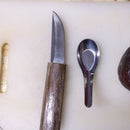Introduction: Basics of Twisting Wire for Jewelry
check out this simple technique of improving the usefulness of plain wires that many people probably already have the tools on hand for already
the earrings were made using 18 gauge steel wire
the bracelet, ring, and penannular brooch were done in recycled copper wire from old electrical cords
Step 1: Tools and Materials Needed
twisting wire is quite basic and chances are you already have everything on hand or can acquire them quite easily at an affordable cost.
tools needs are as followed:
- some sort of vise or clamp( for securing one end of the wire)
- hand crank drill ( for twisting the wire with consistency)
- wire cutters and some pliers ( for cutting wire and bending straight if needed)
- a ruler ( for measuring the length of wire needed)
materials are as followed:
- wire ( whatever type you want/ need)
in general the larger the wire, the more difficult it may be to twist it as well as if the wire is fully annealed or already partially hard
for this demo i used 14 gauge steel wire and a smaller gauge of aluminum wire because it's what i could locate within my clutter right now
SAFETY PRECAUTIONS:
please be careful when working with coiled wire or wire in general as it can have the tendency to whip around which may cause injury if not careful
Step 2: Preparing the Wire for Twisting
first and foremost take into consideration that for each length of twisted wire you want to make, you will need to double it which means if you wish to make a section of 12" twisted wire you will need a minimum of 24" total length of wire
12" x 2 = 24"
preparing the wire:
after selecting your wire and cutting it to length, fold it in half with the two loose ends meeting at center
gripping the two ends by pliers can help keep things even plus preventing the wires from flopping around
thicker wires may need the use of pliers in order to squish the looped end close
Step 3: Twisting the Wire
begin by inserting one end of the wire into the open jaws of the vise and securing it tightly( clamping it to a table or board with a c- clamp works just as good)
afterward insert the two loose ends into the drill chuck and again secure tightly, Ive found this way works better because the two ends can move a bit more freely with the shape of the jaws as it closes
once everything is tight, extend the wire out to a slight tautness this will ensure the twisting operation will yield a more consistent result
now begin twisting the wire by cranking the drill handle until you reach a desired twist
take note that over twisting may result in a kinked and crooked wire like seen in the last couple pictures and will need to be removed by bending with pliers
if the wire is twisted further ...the end result is usually a broken wire
Step 4: Final Thoughts and Another Example
the aluminum wire was much easyier to get a consistent look due to its softness
twisting wire can be a very useful technique to employ and ive seen many nice pieces of jewelry that utilize twisted wire as borders around cabochon settings or stand alone like with other wire wrapped items or of course the items i made pictured at the start
there are an infinite amount of possibilities, its more limited by your overall imagination so give this a try and see where it takes you




